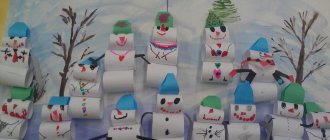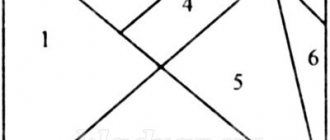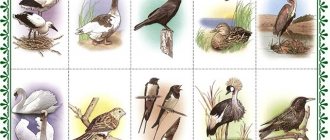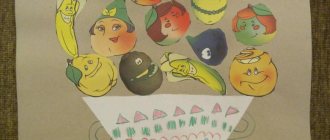MAGAZINE Preschooler.RF
Summary of a lesson in the educational field “Child and Society” “Make friends with a toothbrush”Program objectives: continue to form an understanding of the rules of healthy behavior, hygiene requirements (using the example of brushing teeth); develop the ability to take care of body cleanliness (brush your teeth in the morning and evening, etc.); cultivate the need to comply with hygiene rules that promote health.
Equipment: Bunny toy, wonderful bag with personal hygiene items, different toothbrushes, toothpaste (3-4 types); combs with cotton wool between the teeth, toothbrushes for experience and for exercises (for each child); tables and pictures: “White teeth are needed, strong teeth are important” , “What teeth don’t like” ; model of a jaw with teeth to explain and show how a tooth deteriorates, is treated, black plasticine, corrector; figurative image of a healthy and diseased tooth, food models.
Preliminary work: talk with children about foods that are healthy and harmful for teeth; looking at pictures of what animals need teeth for; reading fiction: I. Gurin “About bad teeth” , etc.
Progress of the lesson
Children become a semicircle. The teacher greets them.
There's a knock on the door.
Educator (V.): Oh, guys, look, Bunny came to visit us. Come in, come in boldly. We always welcome guests. Have a seat.
V.: Look, guys, Bunny didn’t come empty-handed. He brought a bag with him to play a game with you. You guys too, sit on the benches. I will bring the bag to you, and you will take out an object from there and say what we need it for.
D/I “What for what”
Children name the hygiene items that the teacher takes out of the bag and clarify their purpose. The last item is an old comb with broken teeth.
Q: What happened to the comb? Why is she like this? Would you like to have a comb like this? (children’s answers, clarification - the comb is old, you can’t comb your hair with it, your teeth are broken, it’s toothless).
V.: Come on, guys, we’ll give Bunny another comb, a new one. Do you like this comb? What is she like? (Children's answers)
V.: The comb is new, beautiful, it has even teeth, just like yours when you smile. Smile, show your teeth!
Q: Guys, where do teeth live? (In the mouth).
Q: How many teeth do you have? (A lot of).
Q: What color are your teeth? (white).
V.: That’s right, they are white, dressed in a beautiful “shirt” - enamel. Enamel protects teeth from cold, heat, and shock. And here are the gums. Guys, there is a tooth root in it, look what it is like. The root holds the tooth tightly, so it does not fall or become loose.
Q: What are teeth used for? (To chew food, for a beautiful smile).
Q: Only humans have teeth? (Animals have teeth too)
Q: Why do animals need teeth? (Animals use their teeth not only for food, but also for protection from enemies).
V.: Teeth are not just for beauty; they bite, gnaw, chew - they help us eat. Teeth are our helpers. But you and I must help them too. Bunny says that she doesn’t know how to help her teeth. Shall we tell him? What should you do to keep your teeth healthy? (look after them, take care of them, take care of them).
V.: Guys, in order to tell Bunny what to do to prevent his teeth from hurting, we will play with you the game “You can and you can’t .
V.: Stand in a circle. I will say a statement: if you agree with it, then clap your hands, and if not, then stomp your feet.
D/I “It’s possible and it’s not possible”
The teacher pronounces phrases, the children approve or disapprove of them with signs.
“The girl is chewing on a pencil” - the children stomp their feet.
“The boy bites the bread” - children clap their palms.
“The girl brushes her teeth in the morning and evening” - the children clap their palms.
“The boy is picking his teeth with a needle” - the children stamp their feet.
“Girl bites an apple” - children clap their palms.
“The boy is cracking a nut shell” - the children stomp their feet.
“The girl bites the carrot” - children clap their palms.
“A boy goes to the dentist” - children clap their hands.
“The boy eats vegetables, fruits, dairy products” - children clap their palms.
V.: Well done! You know the rules of dental care well. Have a seat!
D/I “Happy-sad tooth”
V.: Please look here. (2 posters: one depicts a sad tooth, the other a cheerful one). What is drawn here? (Teeth). Guys, why are they so strange? One tooth is cheerful, smiling, and the other is sad, even crying. How do you think? (he has a hole, he is sick, he has caries).
V.: Because of sweets, microbes settled on the teeth and began to spoil the teeth. A hole appeared in them. Dental disease is called caries. It makes my tooth hurt. (The teacher draws the children’s attention to a model of a jaw with teeth, one of which has a black dot called caries).
V.: You cannot tolerate toothache. You need to see a doctor immediately. Who can tell me what they call a doctor who treats teeth? (Dentist) He will clean your tooth, put a filling and the tooth will stop hurting. Watch me do it! (The teacher covers up a black hole in the tooth with a corrector)
V.: Now let’s rest a little!
Fizkul (children’s improvisation to an audio recording of V. Shainsky’s song “Smile” )
V.: And in order for your teeth not to hurt, but to always be beautiful and healthy, you need to take care of them and strengthen them - eat foods that are healthy for your teeth. Let's tell Bunny what kind of products these are. “Foods that are healthy and harmful for teeth” will help us with this .
D/I “Foods that are healthy and harmful for teeth .
The teacher lays out models of foods that are healthy and harmful to teeth on the table. Children come up to the table one at a time, take one object and place it near a happy or sad tooth (depending on the benefit or harm of this product for the tooth).
V.: Well, Bunny, now you know what foods you need to eat to strengthen your teeth. And now I will show you how to brush your teeth correctly. But first, let's try to help Bunny choose toothpaste and a brush. Children choose and explain their choice (new children's brush and children's toothpaste).
The teacher comes to the table, takes a model of teeth, a toothbrush and shows the steps of proper brushing of teeth on the model.
V.: You need to brush your teeth from top to bottom. Each tooth must be brushed at least 10 times on one side and the same number of times on the other side. When we eat, small particles of food accumulate between the teeth. If they are not removed in time, a large number of microbes form on the teeth, which over time can destroy the entire tooth. You should brush your teeth twice a day: morning and evening. Before brushing your teeth, you need to wash your hands, wash your brush with soap, and place the toothpaste over the entire length of the brush. When you have brushed your teeth, rinse your mouth well with water and wash the brush with soap, and then place the brush in a cup or stand.
Q: Do you remember how to brush your teeth correctly? Want to try it yourself? (Children's answers)
The teacher uses as a model - a comb is teeth, cotton wool is food. Children repeat the teacher’s actions (old washed brushes, combs with cotton wool between the teeth); they try to draw conclusions: you need to brush your teeth from top to bottom, from both sides).
V.: Guys, Bunny says that he understands everything, he wants to take your toothbrush, quickly clean it and return it. Is it possible to do this? (No)
Children: You cannot give your toothbrush to anyone.
V.: Guys, we are such good fellows: we helped Bunny, and we remembered all the rules ourselves. Who can tell me what useful tips and rules for dental care you learned today?
The teacher listens to all the children's answers.
V.: The bunny thanks you for teaching him how to brush his teeth and telling him how to care for them. Now I’ll go and tell my forest friends.
Deputy head for main activities: Vasilevskaya T.M.
LITERATURE:
- Skrebtsova, O.E. Children about health and safety: Sat. subject materials on familiarization with the outside world and speech development of preschoolers / O.E. Skrebtsova, G.V. Trafimova. – Minsk: Nar. Asveta, 2011. – 191 p.
- Preschool education curriculum. -Minsk: NIO, 2012.
| Next > |
Child and society article on the topic
CHILD AND SOCIETY
Relationships with other people begin and develop most intensively in preschool age. The first experience of such relationships becomes the foundation on which further personal development is built. The subsequent path of his personal and social development, and therefore his future fate, largely depends on how the child’s relationships develop in the first group of peers in his life - in the kindergarten group.
As studies have shown, at different stages of a child’s genetic development, the main communicative need changes and becomes more complex. Thus, in children 2–4 years old, the main communicative need is the need for the complicity of a peer, which is expressed in the simultaneous and identical actions of children. Children between the ages of 4 and 6 years old develop a need for joint activities with peers. At the age of 6–7 years, stable selective preferences between children develop.
Young children are often “captured by emotions” because they cannot yet control their feelings, which leads to impulsive behavior and difficulties in communicating with peers and adults. The problem is that children are egocentric; as a rule, in relation to other people, their own “I” often prevails.
The task of a teacher, an adult, is to help a preschooler develop a sense of self-confidence, teach him to consciously perceive the emotional state of himself and those around him, and also build relationships in interaction.
Emotions play an important role in children’s lives: they help them perceive reality and respond to it. The little man encounters the diversity of the world around him: objects, events, people. His parents introduce him to everything that surrounds him. Adults always, in one form or another, express their attitude towards things and phenomena using intonation, facial expressions, gestures and speech. While learning about the world around us, the child receives standards of relationships and displays a pronounced and selective attitude towards both objects and people. The child clearly distinguishes his loved ones from the people around him, showing his emotional state, makes it clear to his loved ones what he likes and what makes him angry.
In recent years, significant changes have occurred in the emotional sphere of the child. This is influenced by many factors: on the one hand, stressful situations, adult problems, low living standards, and on the other hand, the technologization of life. More and more children are appearing with disorders in psycho-emotional development, which include emotional instability, hostility, aggressiveness and anxiety.
An adult’s inattentive attitude towards a child significantly reduces his social activity: the child withdraws into himself, becomes constrained, insecure, ready to cry or take out his aggression on his peers.
The main goal of my activity is to promote the mental and personal growth of the child, creating an emotional happy mood in the group.
But the teacher also needs the help of parents, because mother and father are the first and main educators. They teach children to understand people and value life. They pass on the best to their children. Society is a huge house built from small bricks - families. And strong bricks mean a strong house. The interests of father and mother should be directed towards a common goal: to raise children physically and morally healthy.
Family feelings become a school of personal spiritual qualities for children. From these feelings, children learn love, friendship, submission and leadership, and learn to be a man and a woman.
Teaching a child to see and understand people is perhaps the most difficult thing in the difficult task of raising a person. Parental love should be such that the child awakens the sensitivity of the heart to the world around him, to everything that a person creates, that serves a person, and, of course, first of all, to the person himself. The feelings on which a good family of good people relies are similar to building blocks of happiness, and from them you can create an island of “home paradise”. Family can be the main source of happiness in our lives, but under one condition: treat others as yourself, try to give others and yourself this happiness.





